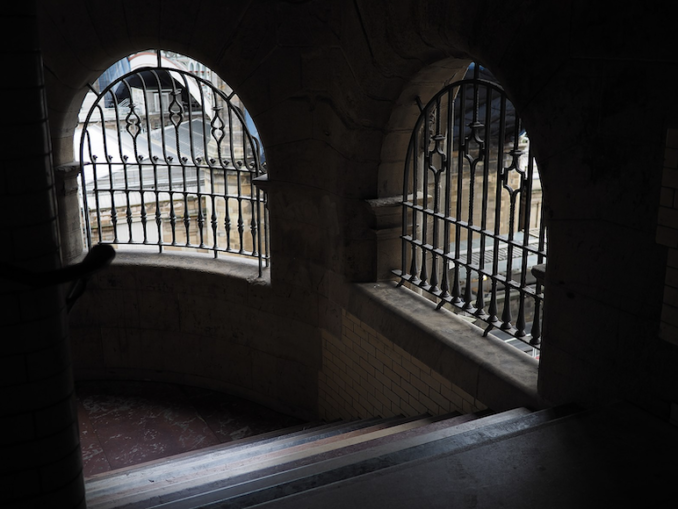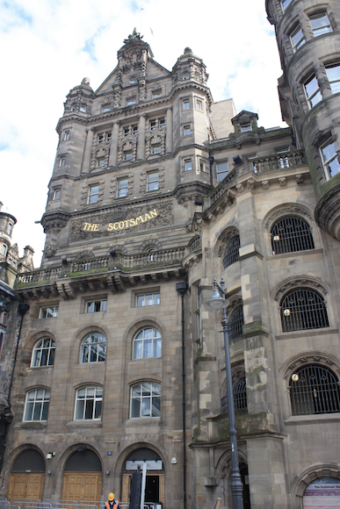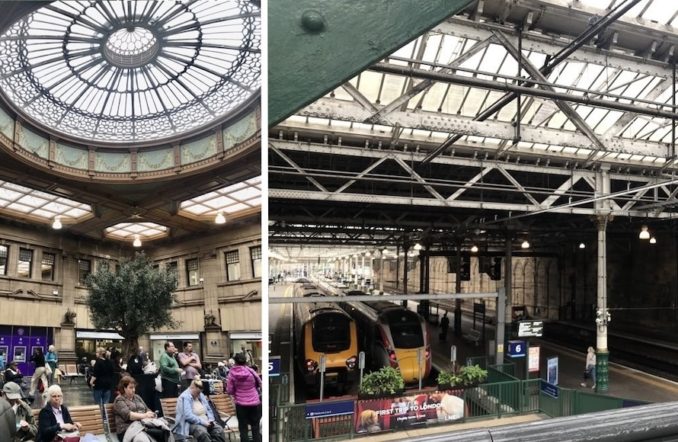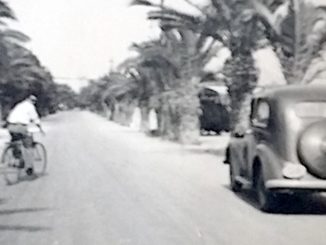Mrs AWS and I are enjoying our May day-trip to Edinburgh, but time is tight. After walloping down (£10) ice creams, we must hurry to Waverley station if only to watch our train depart the platform without us. It’s only 2 p.m., but we can’t afford two ninety-nines, a trip to The King’s Gallery at Holyroodhouse Palace and peak-time travel.
We pause at a street corner just west of St Giles Cathedral, obliged to a secret ritual. I hold up a hand missing half a finger lost in a Davao City mahjong den while defending what was left of the honour of a Benedictine mother superior’s fallen niece. I roll up my trouser leg to expose a crocodile bite earned at a Myappi Falls swimming afternoon when diving for a district commissioner’s lost timepiece.
Mrs AWS throws her head to one side to expose a now near-invisible puncture mark (which caused her neck to swell to eight times its normal size) after a tropical bite in a dark corner while looking for a missing finger.
It takes two years to build a frigate and two hundred to build a tradition, and it is traditional for couples like ourselves to, with discretion, show our duelling scars at this street corner.
Why so? The thoroughfare contains the Scottish National Library, which in turn holds Patrick Leigh Fermor’s Green Diary. Paddy was a fellow travelling gentleman of adventure and teller of tall tales – gleaned from the ripping yarns fate forces upon one during a life more interesting. He had it a bit easier than myself and my wife of 28 years, and kept his Green Diary while walking crossing the Balkans to Istanbul in the 1930s. Worth a read all the same.
Which gave me an idea. Other treasured exhibits in the library include the first edition of The Scotsman newspaper. We hurry down the Royal Mile and then take an unexpected left. Despite still being in the Old Town and needing to be in the New Town and being 100 feet above the impressive cantilevered roof of Edinburgh Waverley railway station, salvation is at hand…
The Scotsman Steps
The Scotsman Steps is a unique and historic pedestrian staircase connecting the city’s Old Town and New Town and providing a steep but convenient passage from Market Street to North Bridge.
Built in the late 19th century, they are named after The Scotsman newspaper, whose offices once stood nearby in the grand Scotsman Building. The steps themselves have become an iconic part of Edinburgh’s urban landscape, frequented by locals, tourists and hurrying day-trippers alike.

Edinburgh, North Bridge, Scotsman Steps,
ToyHorse – Licence CC BY-SA 4.0
In recent years, The Scotsman Steps underwent a remarkable transformation as part of an art installation by Turner Prize-winning artist Martin Creed. This project, completed in 2011, involved cladding each of the 104 steps in a different type of marble sourced from around the world.
The result is a vibrant and colourful mosaic, with each step showcasing a unique hue and pattern. This artistic intervention elevates the steps from a functional pathway to a celebrated piece of public art. In doing so, enhancing the aesthetic appeal of the area and inviting visitors to engage with the space in a new and playful way. Undoubtedly true, but we were too busy taking the steps three at a time to notice.
The Scotsman
The Scotsman is still published, albeit from nondescript offices at 83 Princess Street. The Scotsman Building remains and is a luxury hotel, The Scotsman Hotel, which opened in 2001 and where rooms hover around the £500 a night mark in mid-summer. The hotel retains much of the building’s original grandeur, with many of its public spaces and guest rooms reflecting the elegance of its early 20th-century origins.
The Scotsman newspaper, a cornerstone of Scottish journalism, was founded in 1817 by lawyer William Ritchie and customs official Charles Maclaren. Launched as a liberal weekly publication, it aimed to offer an independent voice free from political and commercial influence. The Scotsman gained a reputation for its rigorous journalism and commitment to progressive causes, advocating for political reform, free trade, and civil liberties.
In 1855, the abolition of stamp duty on newspapers allowed The Scotsman to expand its reach by transitioning to a daily format. This move, along with technological advancements like the steam-powered printing press, boosted its circulation. The newspaper continued to grow, both in influence and readership, and by the late 19th century, it had established itself as one of Scotland’s leading newspapers.
In 1905, The Scotsman moved into its iconic headquarters on North Bridge in Edinburgh. The building, designed by renowned architect John Wilson, is in the grand Scottish Baronial style which is characterised by its robust stonework, turrets, and intricate detailing.

Scotsman Buildings as seen from below,
Stephencdickson – Licence CC BY-SA 3.0
The building’s design reflected the newspaper’s stature, with its imposing façade and elaborate interiors that include ornate staircases, high ceilings, and large windows offering sweeping views over Edinburgh.
This period marked a golden age for the newspaper, characterised by high-quality journalism and extensive coverage of national and international news. The paper’s editorial stance remained liberal, supporting causes such as home rule for Scotland and social justice issues.
The mid-20th century brought challenges, including the impact of World War II and the rise of television as a dominant news medium. Despite these changes, The Scotsman adapted, continuing to provide comprehensive news coverage and in-depth analysis. In 1994, the newspaper embraced the digital age by launching its online edition, expanding its audience beyond Scotland. By 2022, the online reach of scotsman.com totalled five million adults per month.
Today, The Scotsman remains a voice in Scottish media, although the internet and the emergence of multi-channel digital TV saw its audited print circulation dropping to 7,700 by late 2023.
Waverley Station
At the bottom of the steps, we find ourselves back where we started at the Market Street entrance/exit to Waverley station. The station’s origins can be traced back to the mid-19th century, a period of rapid industrial growth and expanding railway networks. It opened in 1846, bringing together lines from three different railway companies: the Edinburgh and Glasgow Railway, the North British Railway, and the Edinburgh, Leith and Newhaven Railway. This consolidation marked the beginning of Waverley as a central node in Scotland’s transportation system.
The station takes its name in homage to Sir Walter Scott’s celebrated Waverley novels, as the famous Scottish author’s works were popular at the time. To begin with, Waverley Station was a modest structure, but the burgeoning demand for rail travel soon necessitated significant expansions. The most notable of these early developments occurred in the 1860s and 1870s, with the station rebuilt to accommodate increasing passenger numbers and more complex train operations.

© Always Worth Saying 2024, Going Postal
The construction of its expansive glass roof, completed in 1900, was a significant feat of Victorian engineering. This roof, spanning over 50,000 square meters (25 acres), allows natural light to illuminate the vast concourse, creating a bright and airy environment for travellers. The station’s design incorporated intricate ironwork and stone masonry, reflecting the grandeur and ambition of the era.
At present, there are 22 platforms, numbered 1 to 20, with platforms 8 and 9 split into east and west – the westbound for Avanti services to London Euston and the ‘easts’ for LNER trains to London Kings Cross.
Arriving fashionably early, à la Fermor at a Hapsburg embassy reception, we have time for Burger King. In the mad world of railway pricing, our First Class meal on the way home would have cost £90, so we’re travelling Standard Premium. In the same type of carriage, but you bring your own food. We raided Burger King in the waiting room. With not as much left from £90 as one might hope, we walked gingerly to platform nine for our awaiting train.
While we’re on the subject, if you’re strolling along the Royal Mile and spot a lopsided Scotsman lifting his kilt in the general direction of a national library, it will be Angus. An ex-Navy man horribly caught out while making his escape across a Waziristan hillside when his camel was startled by a troublesome local commander’s exploding yurt.
Always a short fuse man, Angus’s other weakness was riding his beast with a saddle – one that included a double handrest in front of the crotch. Never the same again. Humour him.
© Always Worth Saying 2024


